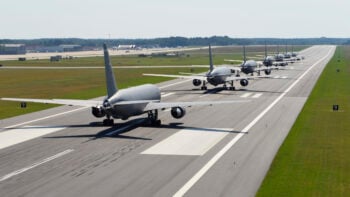
Marines with 2nd Battalion, 1st Marines, participate in Counter-Unmanned Aircraft System (UAS) training in the United States Central Command area of operations. (Marine Corps/Gunnery Sgt. Melissa Marnell)
AUSA 2022 — The conflict in Ukraine has only reinforced and crystalized an important lesson for the US military: They’ll need more than one option to counter the growing threat from unmanned systems.
The threats are diverse, ranging from sophisticated, long-range cruise missiles to off-the-shelf quadcopters, and therefore the defenses must be as well, according to Maj. Gen. Sean A. Gainey, director of the Army’s Counter-Unmanned Aircraft Systems Office.
Gainey said this is no “silver bullet,” and that an effective counter-drone (cUAS) strategy will depend on a “layered approach” to defenses, whether it’s kinetic, electronic, directed energy or microwave systems, and called on industry to present their own ideas so the service can work them into the layers.
“When you get to volume, how do you get a range of systems that respond to volume?” he asked, before quickly reassuring the audience at the annual Association of the United States Army conference that the Army already does have some potent drone defenses.
Gainey noted that the electronic systems work “pretty good” against smaller unmanned systems, but he has previously said that the rise of autonomy in unmanned operations has limited the effectiveness of EW as “now you’re not cutting a link.”
RELATED: The ‘Kinetic Pendulum’: How the Army wants to defeat drone threats
Today Gainey suggested it’s still been difficult to convince some stakeholders that cUAS is as serious of a problem as he sees it, especially for the smaller, quadcopter-type threats.
“There are some that will believe that it’s more of a hazard,” he said. But the Army has to “not look at it as a hazard, but a threat.”
One place the US has seen the threat, Gainey said, was at Central Command — a threat that “retriculates into Ukraine.” That appears to be a reference to Iran’s unmanned capabilities, which have long concerned US officials (and others) in the Middle East and have been exported to Russian forces.
But while Gainey and his fellow officials spent time pitching to industry to help come up with creative cUAS solutions, they also focused on another key aspect of the Army’s cUAS initiative: training.
Currently there’s a cUAS “academy” out in Yuma, Ariz., but that’s a two-week-long course. The panelists said they aim to expand it as part of a broader effort to spread counter-drone knowledge across the service. There soldiers — and airmen, Marines, Secret Service agents and whoever else wants to come — learn to use “electronic drone busters to scramble their navigation and send them flying back to whoever is controlling them,” according to an Army article.
But despite the urgency with which the Army is trying to move, Gainey said they envision a new, three-week course standing up not before fiscal year 2025.























